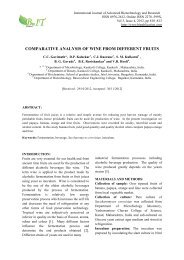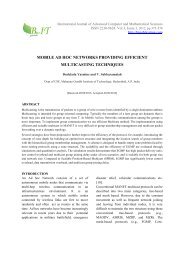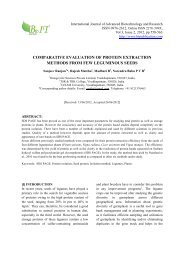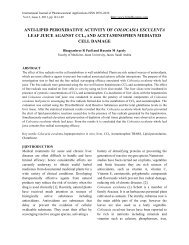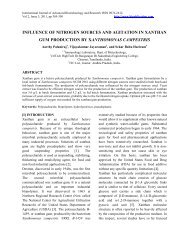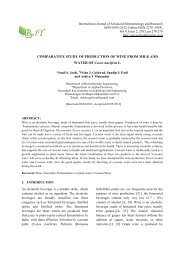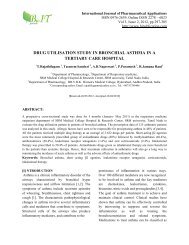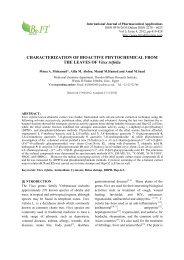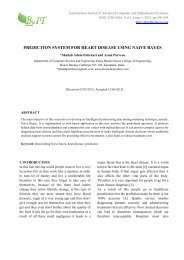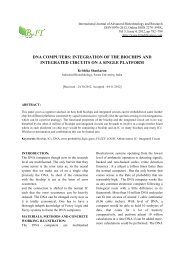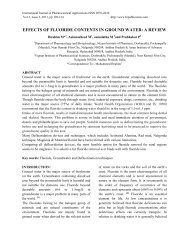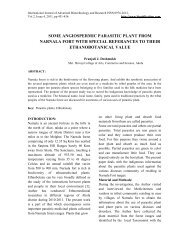isolation and characterization of chromium removing bacteria from ...
isolation and characterization of chromium removing bacteria from ...
isolation and characterization of chromium removing bacteria from ...
You also want an ePaper? Increase the reach of your titles
YUMPU automatically turns print PDFs into web optimized ePapers that Google loves.
ISOLATION AND CHARACTERIZATION OF CHROMIUM REMOVING BACTERIAhas the potency to remove <strong>chromium</strong> <strong>from</strong>industrial effluent [25].The average levels <strong>of</strong> sodium, potassium,<strong>chromium</strong>, zinc, cadmium, nickel <strong>and</strong> copperwere found to be more in the effluentcontaminated soil collected <strong>from</strong> effluentreceiving sites. It was reported that the levels<strong>of</strong> exchangeable cations (sodium <strong>and</strong>potassium) in the soil irrigated with tannerywaste water were found to be high [16].Microorganisms adapt to the heavy metalpolluted soil by changing their intrinsicbiochemical <strong>and</strong> structural properties <strong>and</strong>physiology <strong>of</strong> the organism. Therefore, thesurvival <strong>of</strong> microbes in polluted soil is proneto show higher resistance to heavy metals ascompared to population in non-contaminatedsites [36].REFERECNCES[1] American Public Health Association (APHA)[2005]. St<strong>and</strong>ard Methods for the Examination <strong>of</strong>Water <strong>and</strong> Waste Water, 21st ed. American WaterWorks Association, Water Environmentfederation, Washington DC.[2] Arundhati P , Paul AK.[2004]. Aerobicchromate reduction by <strong>chromium</strong> resistant<strong>bacteria</strong> isolated <strong>from</strong> serpentine soil. Microbiol.Res. 159: 347-374.[3] Balakrishnan V ,Karruppusamy S. [2005].Physico-chemical characteristics <strong>of</strong> drinkingwater samples <strong>of</strong> Palani, Tamil Nadu. J.Ectoxicol. Environ. Monitor. 15 (3): 235-238.[4] Bureau <strong>of</strong> Indian St<strong>and</strong>ards (BIS). [2009].Indian St<strong>and</strong>ard Drinking Water Specification (IS:10500) New Delhi.[5] Benedict C, Okeke L, Laymon J , CrenshawSOJIC. [2008]. Environmental <strong>and</strong> kineticparameters for Cr (VI) bioreduction by a <strong>bacteria</strong>lmonoculture purified <strong>from</strong> Cr (VI) resistantconsortium. Biol. Trace Element Res. 123: 229-241.[6] Bhalli JA , Quiser MK. [2006]. Pollution levelanalysis in tannery effluents collected <strong>from</strong> threedifferent cities <strong>of</strong> Punjab. Pak. J. Biol. Sci., 9 (3):418–421.[7] Camargo FAO, Bento FM, Okeke BC ,Frankebagu WT.[2003]. Chromate reduction by<strong>chromium</strong> resistance <strong>bacteria</strong> isolated <strong>from</strong> soilscontaminated with dichromate. J. Environ. Qual.32: 1228-1233.[8] Chakrapani GJ.[2005]. Major trace elementgeochemistry in upper Ganga River in theHimalayas. Indian Environ. Geol. 48: 189-201.[9]Chidambaram,A.,Sundaramoorthy,P.,Murugan,A.,Ganesh,K.S.,Baskaran[2009].Chromium induced cytotoxicityin black gram, J Environ Health Sci Eng, 6: 17-22.[10] Colak S, Ozgunay H, Mutlu MM , AkyuzF.[2005]. Reducing the amount <strong>of</strong> tanningmaterials passing into wastewater in post-tanningprocesses. J. Amer. Hlth. Chemists Assoc. 100 (3):111-119.[11] Dubey RC , Maheswari DK. [2002].Practical Microbiology, 1 st edition.Elangovan R, Abihipsa S, Rohit B, Ligy P ,Ch<strong>and</strong>raraj K. [2006]. Reduction <strong>of</strong> Cr (VI) by aBacillus sp, Biotechnology, 28: 247-252.[12] Faryal R, Yusuf M, Munil K, Tahir F ,Hameed A. [2007. Enhancement <strong>of</strong> Cr 6+ removalby Aspergillus niger RH1 using a Bi<strong>of</strong>ermenter.Pak. J. Bot. 39 (5): 1873-1881.[13] Franco AR, Calheiros CSC, Pacheco CC,Marco P, Mnaia CM ,Castro PML. [2005].Isolation <strong>and</strong> <strong>characterization</strong> <strong>of</strong> polymericGalloyl-Ester-degrading <strong>bacteria</strong> <strong>from</strong> a tannerydischarge place. Microbial Ecol. 50: 550-556.[14] Ganguli A ,Tripahi AK. [2002].Bioremediation <strong>of</strong> toxic <strong>chromium</strong> <strong>from</strong>electroplating effluent by chromate reducingPseudomonas aeruginosa A2 Cr in bioreactor.Appl. Microbiol. Biotech. 58 (3): 416-420.[15] Kannan M. [2003]. H<strong>and</strong>book <strong>of</strong> LaboratoryCulture Media, Reagents, Strains <strong>and</strong> Buffer,Panima Publishing Corporation, New Delhi,India, p. 77.[16] Krishna G. [2008]. Assessment <strong>of</strong> heavymetal contamination in soils around ManaliIndustrial area, Chennai. Southern India. Environ.Geol. 54: 1465–1472.Smrithi A <strong>and</strong> Usha K 649



